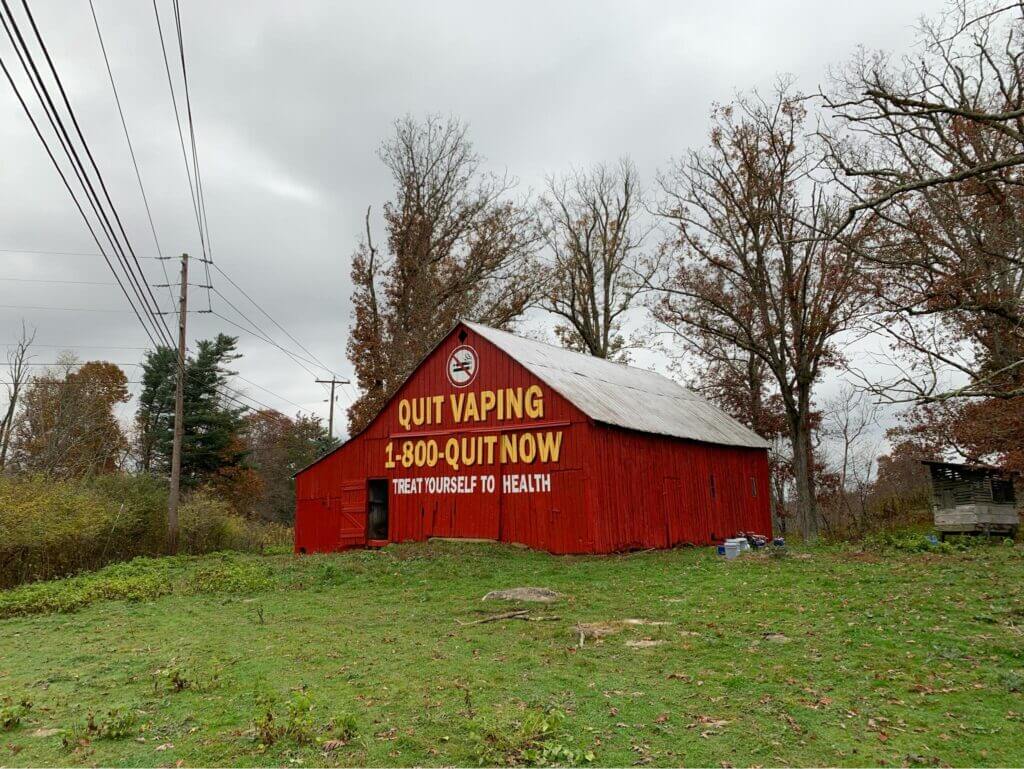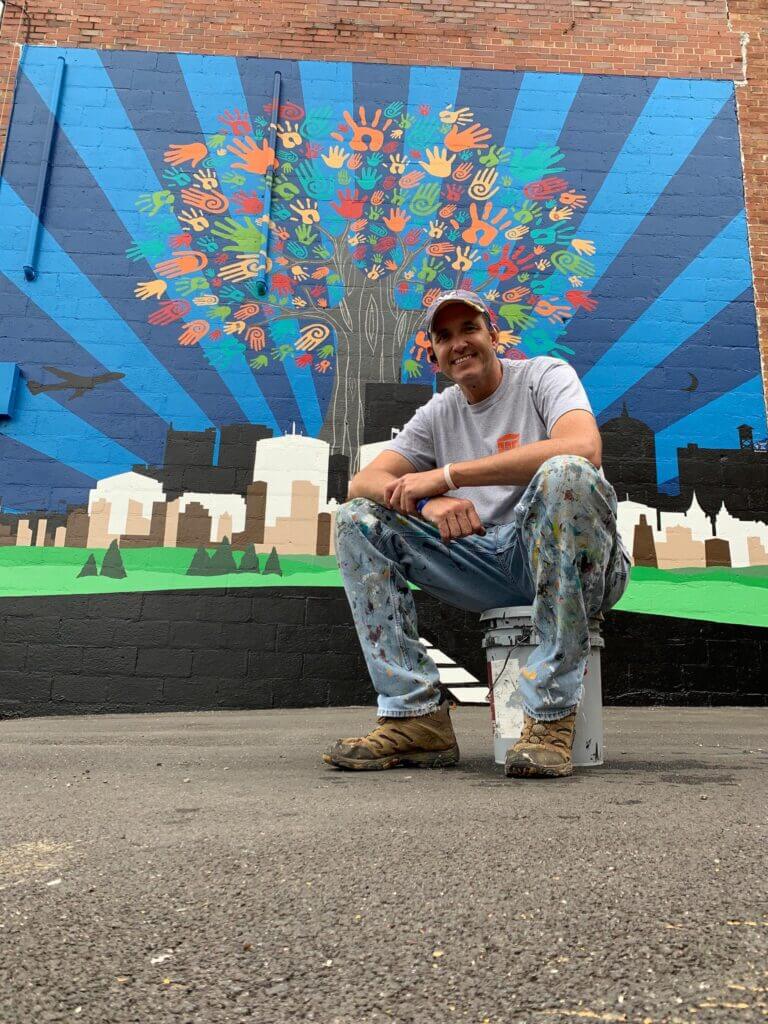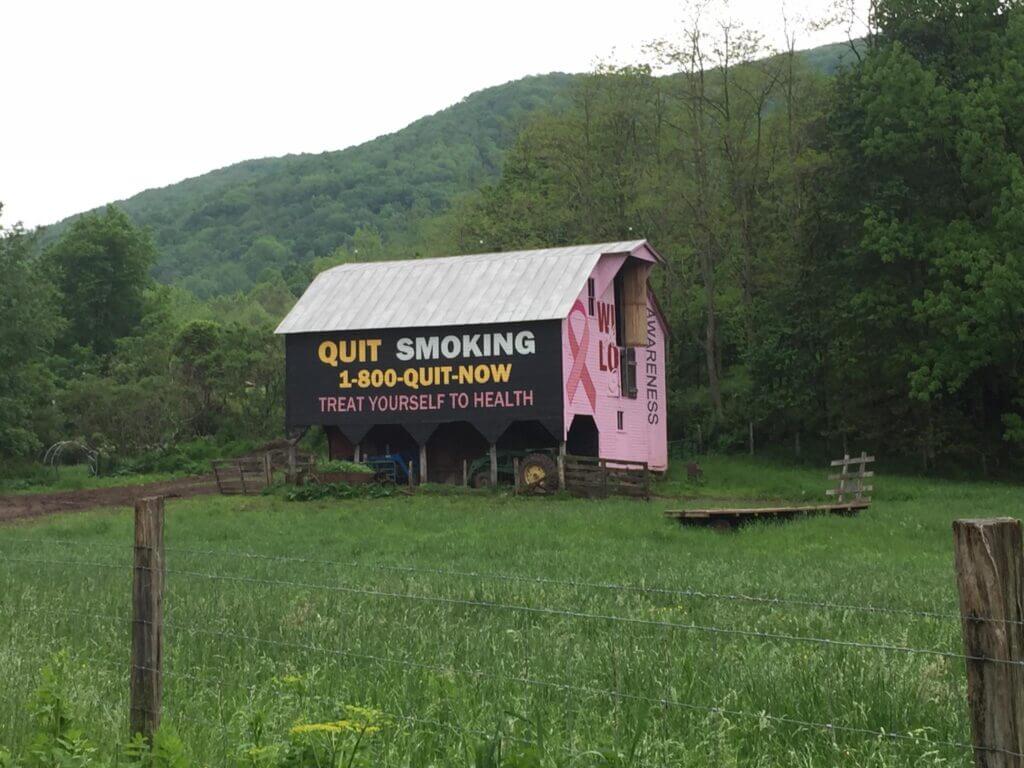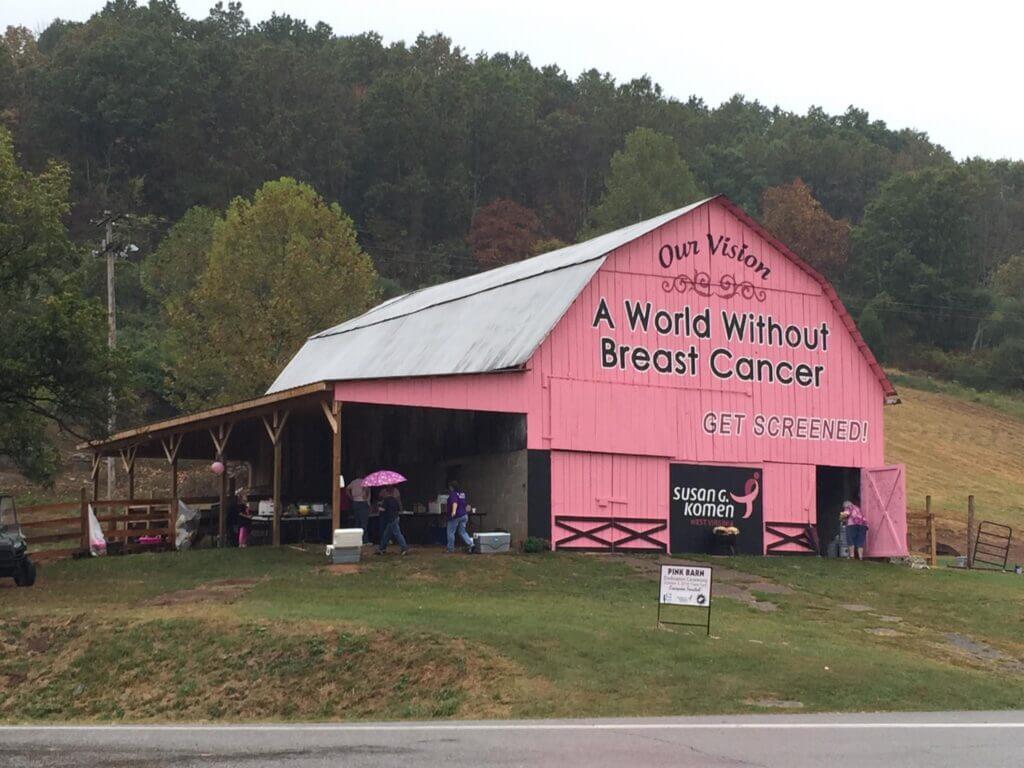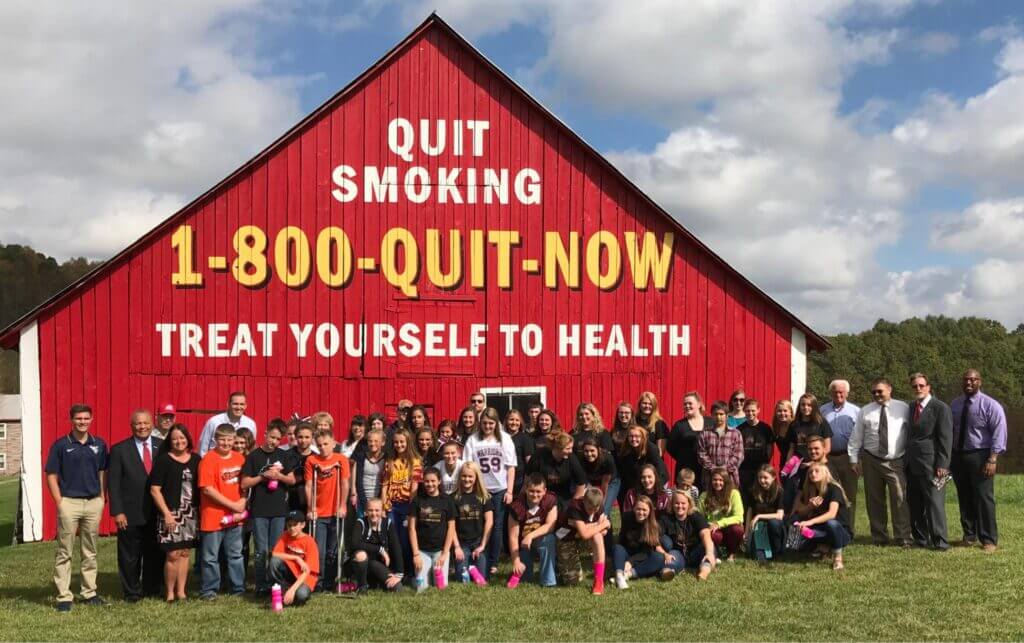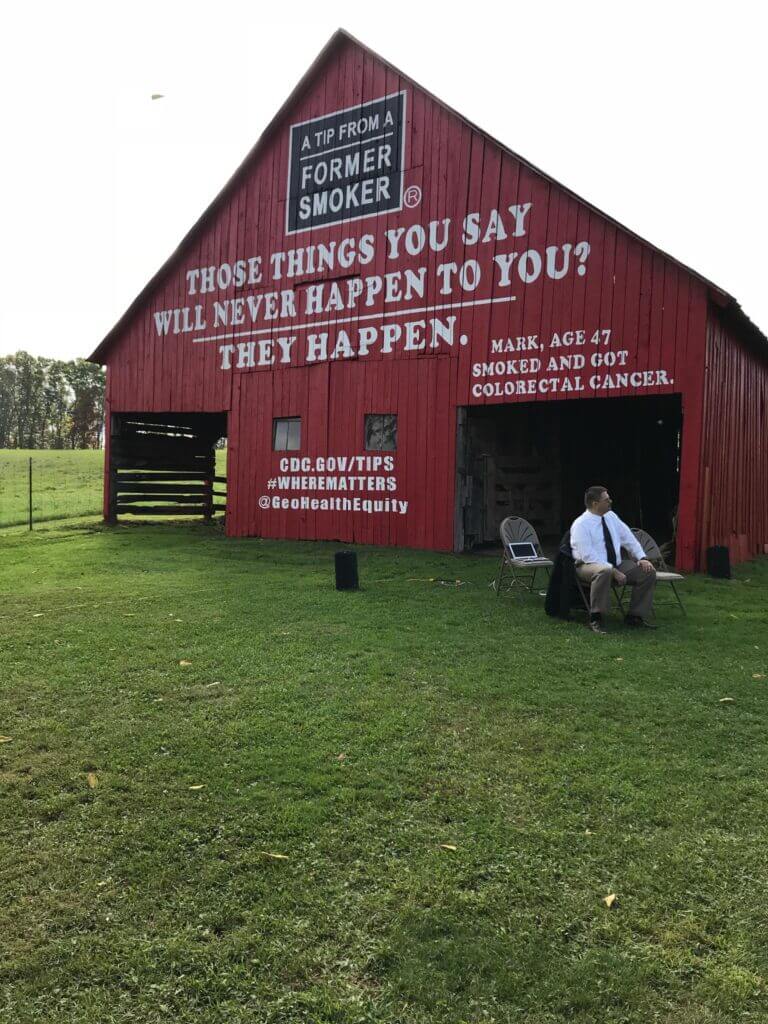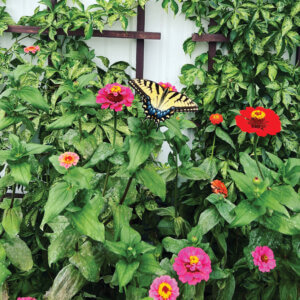
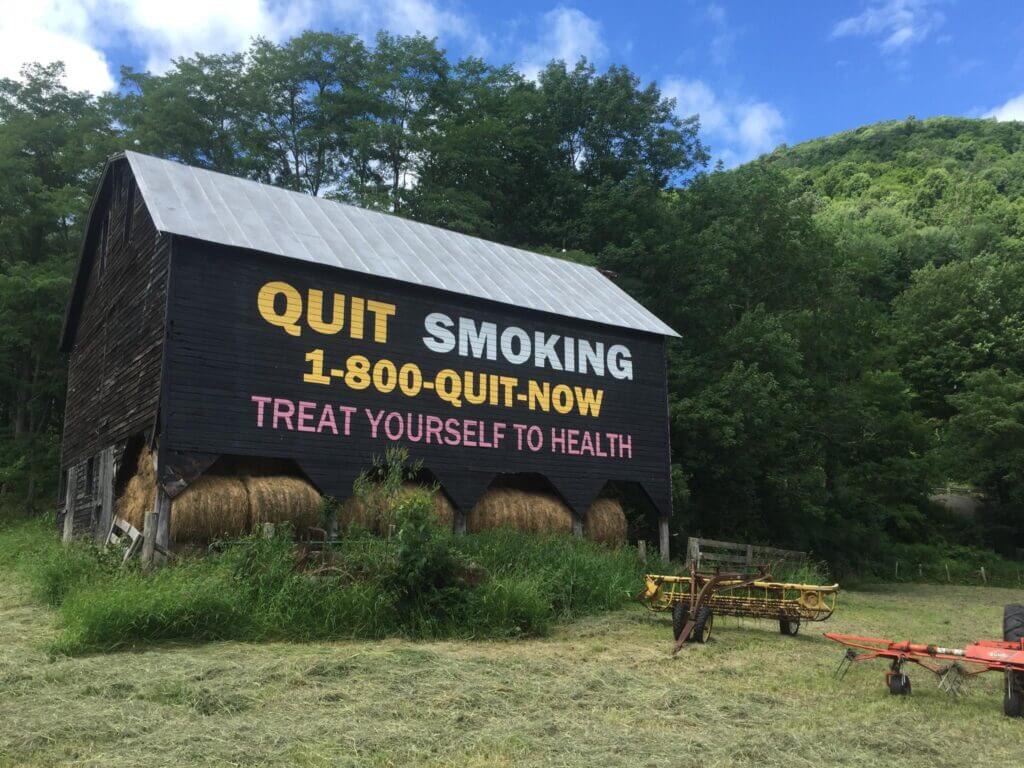
courtesy of Greg Puckett
An anti-tobacco campaign plays on the Mail Pouch tradition to spread its life-saving message.
This story was originally published in the January 2021 issue of Wonderful West Virginia. To subscribe, visit wonderfulwv.com.
written by Holly Leleux-Thubron
Greg Puckett is a Mercer County commissioner, an executive director, a change agent, and a man with a fondness for painting giant things. He’s also a Mail Pouch barn enthusiast, often pulling over on West Virginia’s highways to snap a picture of a newly discovered vestige from a bygone era. Less than half of what once numbered 200 painted barns remain along the state’s country roads. Puckett, like many others, celebrates the tradition. But he’s also a trailblazer, and he was inspired to put a modern twist on it.
Pouch History, West Virginia’s Mural Roots
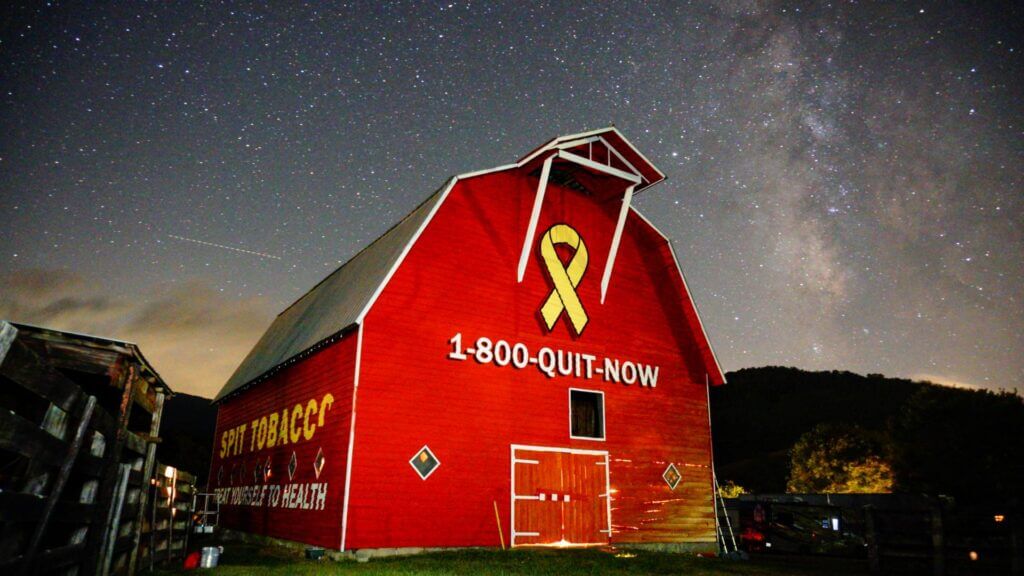
The innovation of the Mail Pouch barn is a familiar story that evokes great pride for state residents, and it goes like this: Aaron and Samuel Bloch operated a dry goods store in Wheeling in the late 19th century. The top floor of the building operated as a tobacco factory. A catastrophic flood in 1884 left the bottom floor in shambles, but the tobacco factory was unscathed. The brothers quickly shifted their full attention to tobacco production.
Marketers well ahead of their time, the Blochs hatched the idea of advertising their tobacco products—most commonly their chewing tobacco brand—on everyday structures like barns and bridges in rural areas where the chewing habit was most popular. They made the prospect of a Mail Pouch barn enticing. Teams of painters employed by the brothers hit the ground scouting barns in ideal locations: spots that were highly visible, with decent traffic flow. A barn that met their criteria would get a fresh coat of paint, offering protection from the elements at no cost to the farmer, and the farmer would be paid around $1 per year in royalties on top of that. It was the consummate win-win. Every few years, a painting crew would return for touch-ups to keep the barn’s mural in great shape.
These roadside murals evolved into national icons and became attractions in their own right. States from West Virginia to Washington were home to more than 22,000 Mail Pouch barns by the mid-century.
Murals as Advertising
The Bloch brothers introduced the country to murals as advertising, and remnants of similar efforts by other business owners can be seen throughout the state. These early murals are examples of business owners using what they could easily get to spread word about their products, says Jeff Pierson, director of public art for the city of Charleston. Billboards and printed signs were hard to come by, but paint and elbow grease were affordable and readily available. The capital city has many examples of these old “ghost murals” near City Hall and along Capitol and Hale streets. Some have been restored, he says, while others have been reimagined.
Pierson has seen increased interest in restoring these “ghost murals” in recent years, from the old Mail Pouch barns to Coca Cola signs that were commonly painted on building facades. In fact, Coca Cola Consolidated launched a large-scale restoration project in 2014 and restored more than 15 of the 100-year-old ghost murals across Appalachia, including in Charleston, Hinton, Morgantown, and Ronceverte.
There is a big difference these days between advertising and murals, and both are regulated by local laws in many places. If a mural advertises a specific business, it is limited in its permitted size and scope. If the application of paint on a surface is simply decorative, or pure public art, the boundaries are much more fluid. Very few limitations apply to old barns.
The interest in restoring old murals is so far-reaching that Scott Hagan can make a living doing it. He’s a full-time barn painter and, from his home in Ohio, criss-crosses the country in his RV painting barns near and far. When the weather’s right, his “office” can’t be beat. He’s probably restored dozens of Mail Pouch murals and painted hundreds of barns in his 20 years of experience.
The fan base for this kind of Americana is huge, according to Hagan. It’s much less about what’s being advertised these days and more about the iconic nature of the barns, he adds. Painted barns capture people’s attention today just as they have for the past 100 years, and that’s exactly what gave Puckett the idea to use them to spread a different message.
Move Over, Mail Pouch
About 15 years ago, Puckett took a trip to the Eastern Panhandle, traveling old roads that still accommodated a handful of Mail Pouch barns. The history of the structures spoke to him on his journey, and he thought about the way that forms of advertising are culturally significant. He stopped at every opportunity along the way to admire the barns and bathe in their history. “I thought, if we were the first to do this and advertise tobacco use his way,” he recalls, “why can’t we be the first in using it for prevention and to help create a healthier alternative to the very same product?”
Ten years ago, as the executive director of Community Connections, Inc., in Princeton, Puckett approached the West Virginia Division of Tobacco Prevention and suggested a counterculture approach that would build on the state’s barn mural history. But rather than promoting tobacco use, this project would promote positive prevention strategies. “For Mail Pouch, it was ‘Treat Yourself to the Best.’ Puckett explains. “For our current project focused on prevention, it’s ‘Treat Yourself to Health.'”
courtesy of Greg Puckett
Hagan has earned a reputation as a premier barn painter, so Puckett knew exactly where to turn for help to bring his idea to life. Together the two men have painted each of the counterculture barns which, by the end of 2020, numbered 15. And Puckett continues the tradition of innovation central to the Mail Pouch barn story. He partnered with a Mineral County restaurant called Millstone Southern Smoked BBQ for one of the anti-smoking barns and used the Center for Disease Control’s “Tips for Former Smokers” message on the structure. The mural was done in partnership with the Community Anti-Drug Coalitions of America and the Geographic Health Alliance, and it achieved two things simultaneously: promoting the business and spreading the word about prevention.
In Harman, Puckett and Hagan showcased the interconnectedness of tobacco use and breast cancer. The Cooper family farm had a magnificent old barn just begging for colorful paint. During conversations with the family and with some help from Randolph County Family Resource Network’s former Director Rebecca Vance, Puckett learned of the family’s breast cancer battles. That, along with the rural area’s high rate of tobacco use, brought a synergy to light, and a can’t-miss masterpiece was born that both was meaningful to the family and advanced Puckett’s mission. Randolph County is now home to the nation’s first barn mural that pays homage to breast cancer awareness—another first in the state’s corner.
Your Next Selfie Spot
In Monroe County, home of the barn that started it all, you’ll find a colorful structure vying for your attention and just a moment to teach you about health issues related to chewing tobacco—and its high rate of use in rural farming communities—in a rural farming community.
“The funny part is that, like the Mail Pouch barns of old, these are now becoming culturally significant in their own right,” Puckett says. “I’ve heard stories of people taking trips just to get photos with the barns. That’s pretty cool.”
courtesy of Greg Puckett
Puckett and Pierson agree that murals are about so much more than art. “Murals are a message of hope and an aspiration for what can be,” Puckett says. “Color changes buildings, but the environmental change is reflected in the hearts and minds of people and their willingness to look at things differently. If the environment changes, so do people. And if enough people change, so does the culture.”
The Bloch brothers, sons of a German immigrant, saw the side of an old barn as an opportunity to achieve their American dream. Puckett sees barns and envisions ways to use them to change the world around him. The immense canvas accommodates each endeavor effortlessly.

